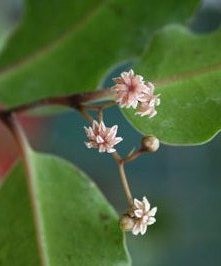Amborella trichopoda
(Amborella trichopoda)

Description
Amborella trichopoda is a species of Magnoliopsida described by Henri Ernest Baillon. Amborella trichopoda belongs to the genus Amborella, and the family Amborellaceae. Amborella is a monotypic genus of understory shrubs or small trees endemic to the main island, Grande Terre, of New Caledonia. The genus is the only member of the family Amborellaceae and the order Amborellales and contains a single species, Amborella trichopoda. Amborella is of great interest to plant systematists because molecular phylogenetic analyses consistently place it as the sister group to all other flowering plants. Amborella is a sprawling shrub or small tree up to 8 m high. It bears alternate, simple evergreen leaves without stipules. The leaves are two-ranked, with distinctly serrated or rippled margins, and about 8 to 10 cm long. Amborella has xylem tissue that differs from that of most other flowering plants. The xylem of Amborella contains only tracheids; vessel elements are absent. Xylem of this form has long been regarded as a primitive feature of flowering plants. The species is dioecious. This means that each plant produces either "male flowers" (meaning that they have functional stamens) or "female flowers" (flowers with functional carpels), but not both. At any one time, a dioecious plant produces only functionally staminate or functionally carpellate flowers. Staminate ("male") Amborella flowers do not have carpels, whereas the carpellate ("female") flowers have non-functional "staminodes", structures resembling stamens in which no pollen develops. Plants may change from one reproductive morphology to the other. In one study, seven cuttings from a staminate plant produced, as expected, staminate flowers at their first flowering, but three of the seven produced carpellate flowers at their second flowering. The small, creamy white flowers are arranged in inflorescences borne in the axils of foliage leaves. The inflorescences have been described as cymes, with up to three orders of branching, each branch being terminated by a flower. Each flower is subtended by bracts. The bracts transition into a perianth of undifferentiated tepals. The tepals typically are arranged in a spiral, but sometimes are whorled at the periphery.
Taxonomic tree:







